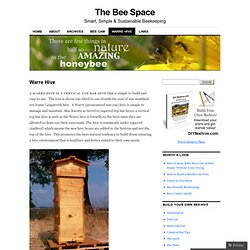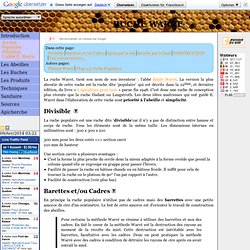

AtelierRucheWarr.pdf. La ruche Warré base carré. Plaquette-apiculture-ecologique. For sale & wanted. Hands on Bees and no gloves on is possible in Ireland! Maisemore Apiaries shop and honey house. Beeginners. FAQ 2 About Honey Bees: All the sort of things you might be interested in as a non-beekeeper.

I wrote this FAQ before I'd ever heard of FAQ's and I called it 'Common Questions about Honey Bees'. When collecting swarms I would chat to the panicking 'victims' and generally win them around to being interested in the life of the honey bee. This was OK but I soon realised that people were often asking the same questions and sometimes I didn't have time to give the whole answer. Eventually I got around to writing down all the answers to the typical questions asked. Index of /warrebeekeeping. How To Build A Kenya Top Bar Hive - Part 1 - Top Bars. Natural beekeeping forum - the home of the Natural Beekeeping Network. High Quality Top Bar Hives from Devon, UK Constructed by an experienced carpenter from locally sourced, seasoned and sustainably-grown larch with oak legs.
The standard measurements are: length 1m overall x 605mm overall width (roof) x depth 470mm (bottom of floor to top of roof) x height 990mm (ground to top of roof). The hive has a pitched roof, internal top bars and dividers and a stainless steel woven mesh bottom - (badger proof!) With a protective hinged wooden cover. The legs are oak for durability and are removable. Price: £195.00 + postage and packing. Bee Friendly Optional Extras: Natural, organic oil/wax finish: £20.00 Larger hive - 1.2 m long: £20.00 Feeder shelf: £7.00 Natural weatherproof finish contains no toxic driers. Call 07930285690 or email greyfieldtimber@googlemail.com Also available: nuc boxes and portable/bait hives.Please call for details. Plans for constructing a Warr hive. PDF metric version for printing (375kb) PDF imperial version for printing (375kb) Plans for constructing a Warré hive -- The People's Hive The plans shown below are based as closely as possible on those in the 12th edition of Beekeeping for All published in 1948.

If you think that we have deviated in any way from those plans, we should be grateful if you would contact us to let us know. The page numbers refer to the pages in the book. At the end of this page we include plans for constructing a box with a window according to the modification of Warré's hive introduced by Frèrès & Guillaume. The plans shown here are based on boxes of 20 mm thick wood, the minimum that Warré regarded as sufficient (p. 52). Imperial measurements. OK Modified Abbé Warré Hive. Sustainable Beekeeping with Warré Hives -- David Heaf's Warré Project Please note: This page is no longer updated.
See Abbé Émile Warré (? -1951) experimented with over 350 hives of various types over a period of 50 years. During that time he developed a bee-friendly fixed-comb hive designed for minimal intervention, easy harvesting and enlargement as well as for producing honey at minimal cost of labour and capital. Pros and Cons A criticism of hives with moveable frames is that the conditions in the colony are far from natural, even if the hive is not repeatedly opened and the frames moved around. Another artifact introduced by modern beekeeping is queen excluders. The bees are allowed to build comb freestyle, subject only to the positioning of top-bars and beads or starter strips of wax. Gobeekeeping. View. Rucher du tilleul. Warre_hive_plans_english. Massivholz-Tischler. The Bee Space. A Warre hive is a vertical top bar hive that is simple to build and easy to use.

The cost is about one-third to one-fourth the cost of one standard ten frame Langstroth hive. A Warre (pronounced war-ray) hive is simple to manage and maintain. Also known as tiered or supered top bar hives, a vertical top bar hive is such as the Warre hive is friendly to the bees since they are allowed to draw out their own comb. The hive is commonly under supered (nadired) which means the new hive boxes are added to the bottom and not the top of the hive. This promotes the bees natural tendency to build down ensuring a hive environment that is healthier and better suited to their own needs. Ruche Populaire Warré. La ruche Warré, tient son nom de son inventeur : l'abbé Emile Warré.

La version la plus aboutie de cette ruche est la ruche dite ‘populaire’ qui est décrite dans la 12ième, et dernière édition, du livre « L'apiculture pour tous » parue fin 1948. C'est donc une ruche de conception plus récente que la ruche Dadant ou Langstroth. Les deux idées maitresses qui ont guidé E. Ruches. Construction d’une ruche Dadant 10 cadres.

Pour une ruchette 6 cadres largeur intérieur = 231mm Toutes les dimensions sont données en millimètres. Il est important de n’avoir qu’un modèle de ruches et qu’elles soient toutes aux mêmes dimensions. Bien respecter les dimensions extérieures ainsi que celles des cadres. Pour la construction j’utilise des planches de résineux de 27 mm qui après dégauchissage et rabotage sont ramenées à 24 mm , en sapin ou épicéa qui, lui, est plus léger.
L’épaisseur de 24 mm permet d’utiliser les chutes pour construire des éléments de cadres, ainsi on retrouve ces 24 mm partout dans la ruche.Le traitement extérieur du bois de la ruche se fait au carbonyle (environ 5 € le litre) ou une peinture microporeuse, l’intérieur est l’affaire des abeilles.Vous pouvez utiliser aussi cette autre méthode: Protection permettant au bois de mieux résister dans le temps, de garder ses ruches en bon état. Ruche en kit dadant 10 cadres TRADITION. Thomas Apiculture. Gilles Fert - Eleveur de reines + auteur de livres. Apiculture : Petites annonces gratuites. Things to do « Beekeeping Success. How to become a beekeeper. The urge to keep bees: How do I start?

The beginner should first of all find out if he/she is in any way allergic to bee stings and if so not to attempt acquiring bees or taking up beekeeping without seeking medical advice. When the urge to keep bees first hits you, the impulse is to go out and buy a hive straight away, and learn by doing in isolation - this is not the best approach. The best first step is to join your local branch of the Beekeepers' Association, preferably in the Autumn. You can then attend their classes for beginners and programme of winter lectures which are held frequently and cover all aspects of beekeeping. There are 45 such Associations scattered throughout the country. Other benefits of membership include the use of a library - video and book, plenty of friendly advice and you are kept up to date with developments within the craft.